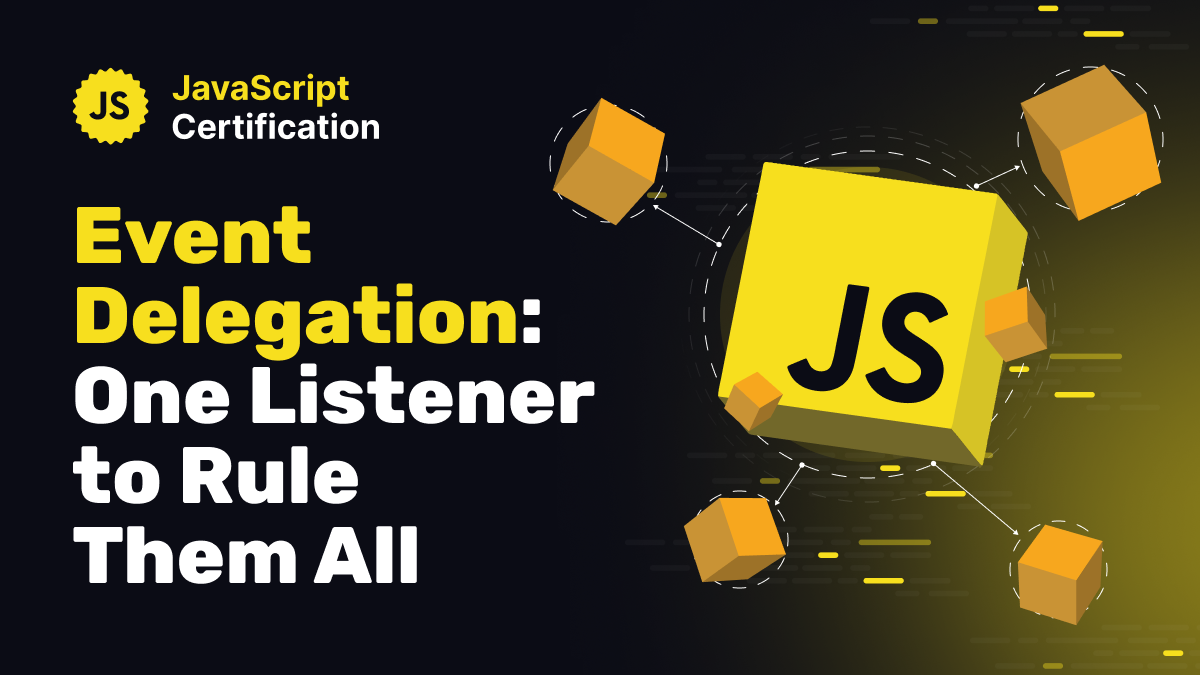
Event Delegation: One Listener to Rule Them All
Learn how event delegation in JavaScript lets you use a single event listener to handle clicks on multiple child elements efficiently—ideal for dynamic UIs and better performance.
Martin Ferret
July 14, 2025
Have you ever added dozens of click event listeners to buttons inside a list, only to realize there might be a better way?
That better way is called event delegation, and it can save you time, memory, and complexity.
What Is Event Delegation?
Event delegation is a technique where you add a single event listener to a parent element, and use it to manage events triggered by its child elements.
Instead of writing:
buttons.forEach(btn => {
btn.addEventListener('click', handleClick);
});
You write:
document.querySelector('#list').addEventListener('click', handleClick);
This works because of event bubbling — when an event is triggered on a child element, it bubbles up through its ancestors.
Why Use Event Delegation?
| Scenario | Event Delegation Advantage |
|---|---|
| Multiple similar elements | Use one listener on the parent |
| Dynamically added elements | No need to reattach listeners |
| Performance optimization | Fewer event listeners = better memory |
| Cleaner code | Centralized logic, easier to maintain |
Example: A To-Do List
Here is our HTML section:
<div id="todo-list">
<button data-id="1">Delete Task 1</button>
<button data-id="2">Delete Task 2</button>
<button data-id="3">Delete Task 3</button>
</div>
Here is the Javascript:
const list = document.getElementById('todo-list');
list.addEventListener('click', function (event) {
if (event.target.tagName === 'BUTTON') {
const taskId = event.target.dataset.id;
console.log(`Deleting task ${taskId}`);
}
});
When you click any button, the console will show:
Deleting task 1
Deleting task 2
Deleting task 3
Only one event listener is used, and it works for all buttons.
Handling Dynamic Elements
Suppose you add a new button dynamically:
const newButton = document.createElement('button');
newButton.textContent = 'Delete Task 4';
newButton.dataset.id = '4';
list.appendChild(newButton);
🔥 You do not need to add a new event listener. The existing listener on the parent will still handle the event. This is one of the main benefits of event delegation.
How It Works: Bubbling and Targeting
Event delegation relies on two key mechanisms:
- Event bubbling: events move from the target element up to the ancestors.
- Event targeting: you check
event.targetto determine which child element triggered the event.
Example:
list.addEventListener('click', function (event) {
if (event.target.matches('button[data-id]')) {
const id = event.target.dataset.id;
// Perform action
}
});
You can also use event.target.closest() if you're dealing with nested elements.
Common Use Cases
- Click events on lists, tables, or menus
- Handling dynamic content loaded via JavaScript
- Form validation on inputs (e.g.,
input,blur) - Toggle switches, tabs, or modals
- Custom dropdowns or UI components
More certificates.dev articles
Get the latest news and updates on developer certifications. Content is updated regularly, so please make sure to bookmark this page or sign up to get the latest content directly in your inbox.

Building Better Abstractions with Vue Render Functions
Learn a practical pattern for using Vue render functions to build better abstractions and simplify your component architecture
Abdelrahman Awad
Jan 8, 2026

JavaScript Isn’t Slow. You’re Just Using It Wrong.
JavaScript is not inherently slow. Poor architectural choices are. Here’s how modern JavaScript actually performs, and where developers really lose speed.
Martin Ferret
Jan 6, 2026

How to animate transitions with Angular?
Angular 20.2 introduces a delightfully simple way to animate elements as they enter and leave the screen. With zero imports and CSS doing all the heavy lifting, the new animate.enter and animate.leave attributes let you add smooth, modern transitions with minimal code and maximum sanity.
Alain Chautard
Dec 26, 2025
Looking for Certified Developers?
We can help you recruit Certified Developers for your organization or project. The team has helped many customers employ suitable resources from a pool of 100s of qualified Developers.
Let us help you get the resources you need.

(a Cisco company)
